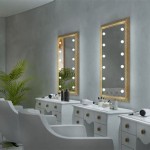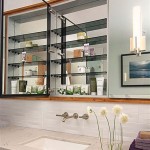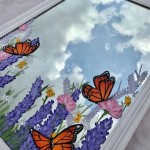Mirror With LED DIY: A Comprehensive Guide
Creating a custom LED mirror is a rewarding project that adds a touch of modern elegance to any space. This guide outlines the steps involved, from choosing the right materials to final installation, providing a clear pathway to a successful DIY experience.
Essential Materials
Gathering the necessary materials beforehand streamlines the construction process. These include:
* Mirror (size and shape depending on preference) * LED Strips (choose warm white, cool white, or RGB for color options) * Power Supply (ensure compatibility with the LED strip voltage and amperage) * Mirror Adhesive or Clips * Wiring, Soldering Iron, and Solder (if necessary for LED connections) * Safety Glasses and Gloves * Measuring Tape and Pencil * Optional: Dimmer Switch, Aluminum Channels for LED stripsChoosing the Right LED Strips
The type of LED strip significantly impacts the final aesthetic. Consider these factors:
* Color Temperature: Warm white creates a cozy ambiance, cool white provides a brighter, more modern look, and RGB offers customizable color options. * Density: Measured in LEDs per meter, a higher density results in more even illumination. * Waterproof Rating: For bathroom installations, waterproof (IP67 rated) strips are essential. * Voltage: Commonly 12V or 24V, ensure compatibility with the chosen power supply.Preparing the Mirror
Proper preparation ensures a clean and professional finish:
* Clean the Mirror Surface: Use a glass cleaner to remove any dust or smudges. * Mark LED Placement: Measure and mark the desired location for the LED strips on the back of the mirror. * Test LED Strip Functionality: Before adhering the strips, connect them to the power supply to confirm they are working correctly.Attaching the LED Strips
Careful application of the LED strips is crucial for achieving a polished look:
* Peel and Stick: Most LED strips come with adhesive backing. Carefully peel back a small section and adhere it to the marked location, pressing firmly along the length of the strip. * Aluminum Channels (Optional): For a more professional finish and better heat dissipation, consider mounting the LED strips in aluminum channels before attaching them to the mirror. These channels also provide a cleaner appearance. * Soldering Connections (If Necessary): Some LED strips require soldering to connect various segments or to attach wires to the power supply. Ensure proper polarity during soldering.Wiring and Power Supply
Correct wiring is essential for safe and reliable operation:
* Connect to Power Supply: Follow the instructions provided with the LED strips and power supply to connect the wiring correctly. Ensure proper polarity to avoid damage. * Dimmer Switch Installation (Optional): If using a dimmer switch, wire it according to the manufacturer's instructions between the power supply and the LED strips. * Test Connections: Before finalizing any connections, test the setup again to ensure all components are functioning as intended.Mounting the Mirror
Securely mounting the mirror is the final step:
* Mirror Adhesive: Apply mirror adhesive to the back of the mirror, following the manufacturer's instructions. * Mirror Clips: Alternatively, use mirror clips to secure the mirror to the wall. This method allows for easier removal if necessary. * Consider Wiring Concealment: Plan how to conceal the wiring, either by running it through the wall or using cable management solutions.Safety Precautions
Prioritizing safety throughout the process is paramount:
* Disconnect Power: Always disconnect the power supply before working with any electrical components. * Eye Protection: Wear safety glasses when soldering or working with glass. * Handle Glass with Care: Mirrors can be fragile; handle them with caution to prevent breakage.Troubleshooting
Addressing potential issues efficiently can save time and frustration:
* LEDs Not Lighting Up: Check for loose connections, correct polarity, and ensure the power supply is functioning. * Uneven Lighting: Ensure the LED strips are evenly spaced and securely attached. * Dimmer Switch Not Working: Verify proper wiring and compatibility between the dimmer, power supply, and LED strips.
25 Beautiful Diy Vanity Mirror That Is Easy And To Do Most Of This Projects Can Be Done Un Bathroom Makeover Mirrors Design

How To Diy Vanity Mirror With Led Strip Lights

Diy Light Up Vanity Mirror For 20 With Remote Lights

Diy Led Light Strips For Mirror Practical Advice Nakashi Lighting

Bathroom Remodel Diy Backlit Mirror Leah And Joe Home Projects Crafts

Diy Led Framed Mirror Modern Builds Ep 74

Diy Mirror Lighting Inspired Led

How To Diy Vanity Mirror With Led Strip Lights

Diy Make You Own Led Light Bathroom Mirror

How To Make Cute Lighted Leaning Mirror








